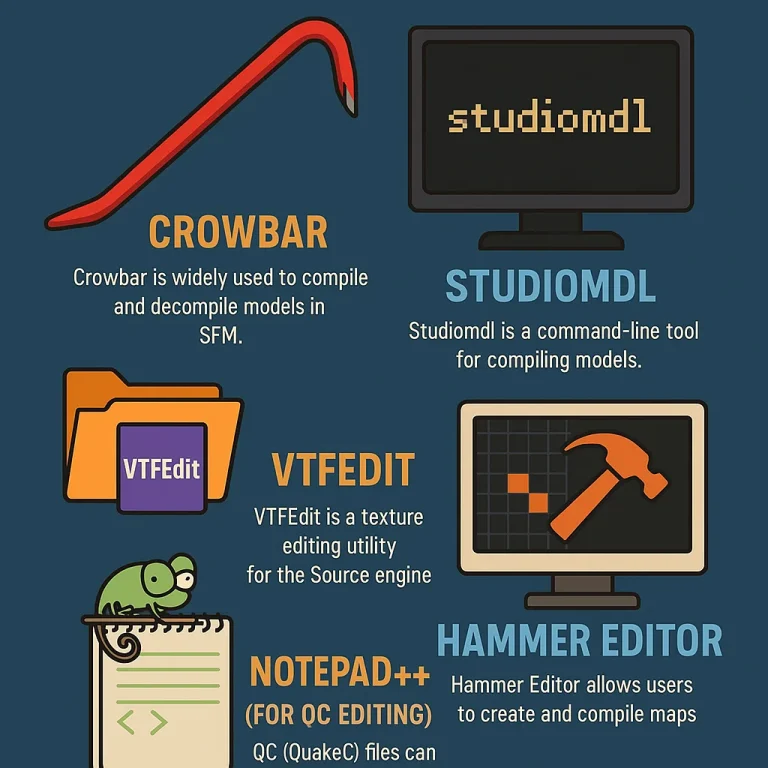SFM Compile: Source Filmmaker Compile Tools Download
Source Filmmaker (SRM) is one of the powerful animation tools that is developed by Valve. This tool allows users to create cinematic animations through assets from Source Engine. Custom models, textures, animations, and maps should be compiled into correct formats before using them in SFM. This process is commonly referred to as SFM Complite that is essential to ensure that asses funtion properly with SFM.

The compilation process should convert raw asset files into optimization formats so Source Engine can interpret them. Raw assets that need conversion include 3D models into MDL format, textures into VTF format, animation into SMD format, and maps into BSP format. If assets are not properly compiled, they may not be displayed correctly, animation may not play smoothly, and maps may fail to load.
This comprehensive guide will give you all the necessary information about SFM Compile, converting tools, methods, and best practices that ensure a smooth workflow. You will learn about these compilation procedures:
- Compiling Models: .MDL Files (compiled from SMD using studiomdl or Crowbar)
- Compiling Textures: .VTF and .VMT files (converted from PNG, JPG, or TGA using VTFEdit)
- Compiling Animations: .ANI files (exported from 3D software and compiled with QC scripts)
- Compiling Maps: .BSP (compiled using the Hammer Editor)
- Troubleshooting common SFM compile errors
Understanding the SFM Compile Process
What is SFM Compilation?
Compiling in Source Filmmaker is the process that enables you to convert raw files such as SMD, TGA, or VMF into Source Source-compatible format that SFM can read easily. This process involves several tools and steps depending on the type of assets you need to compile.
The compilation process is necessary because SFM doesn’t support raw model or texture files. SFM required compiled formats like
- .MDL (for models)
- .VTF and .VMT (for textures)
- .ANI (for animations)
- .BSP (for maps)
The compilation process in Source Filmmaker (SFM) plays a crucial role, especially when working with custom assets. It becomes particularly important in the following scenarios:
- Importing Custom Models or Characters: Proper compilation ensures that models and rigs are recognized and function correctly in SFM.
- Baking Lighting and Shadows into Maps: Accurate lighting effects rely on a successful compilation process to maintain visual quality.
- Creating Props or Particles for Simulation: In-engine simulations require compiled assets for proper physics and behavior.
- Linking Textures and Materials: Compilation helps confirm that all textures and materials are correctly assigned and render as intended.
Unlike many modern game engines that handle compilation in the background, SFM demands manual compilation by the user. This requirement often makes the process both a technical challenge and a creative puzzle for animators and modders.
You should compile each asset correctly, or these assets will not load in SFM.
Why Compilation Is Important?
Compilation makes sure that all assets are optimized for rendering in SFMCompile, preventing performance issues, missing textures, broken animations, or crashes. If there arise an issue while compilation, models may not appear properly or may deform, textures may be missing or distorted, and maps may not load correctly. Proper compilation helps to improve compatibility across different compile SFM projects and aslo reduce rendering errors.
Tools Required for SFM Compilation

Crowbar
Crowbar is widely used to compile and decompile models in SFM (Source Filmmaker). These tools enable users to convert SDM files into MDL format and also extract models from existing Source Engine games. Crowbar gives a user-friendly interface and simplifies the compilation process. It makes it an essential tool for any SFM user.
studiomdl
Studiomdl is one of the most popular command-line tools that is used to compile models from SMD files into MDL format without any third-party application. This tool is part of the Source SDK and it is widely used in the modding and animation communities. Unlike Crowbar, it requires manual command inputs.
VTFEdit
Studiomdl is one of the most popular command-line tools that is used to compile models from SMD files into MDL format without any third-party application. This tool is part of the Source SDK and it is widely used in the modding and animation communities. Unlike Crowbar, it requires manual command inputs.
Hammer Editor
Hammer Editor is the official map editor for the Source Engine. It enables users to create custom maps and compile them into the BSP format, which is necessary for use in SFMCompile. The map compilation procedure involves optimising lighting, adding collision data, and ensuring that all assets are correctly loaded.
Notepad++ (for QC Editing)
QC (QuakeC) files are script files used in the model compilation process. These scripts contain information about the model’s animations, materials, hitboxes, and physics properties. Editing QC files correctly is crucial for ensuring that models function as intended in SFM. Notepad++ is a recommended text editor for working with QC scripts due to its syntax highlighting and user-friendly interface.
How to Compile Models for SFM?
If you want to compile models for SFM FNAF animation, you need to follow this simple set of steps:
Step 1: Preparing the Models in a 3D Software
You have to prepare your models in Blender, Maya, or 3ds Max before you compile these assets. This involves:
- Ensure correct model structure: There should be a proper hierarchy for naming conversion, like bones, mesh, and material
- Apply transformation: You need to make sure the model is correctly oriented and scaled.
- Triangulate the model: You should convert all polygons to triangles before you export files.
Step 2: Exporting to the Correct Format
SFM export model files as an SMD or DMX files after models got ready for compilation
- SMD (Studio Model Data): It is one of the most common format but doesn’t support advanced features like shape keys.
- DMX (Data Model eXchange): It supports shared keys and advanced animations, but it is less commonly used.
Step 3: Writing a QC File
QC (QuakeC) is necessary for compiling the model. It defines the way the model should be processed, including materials, hitboxes, and Physics.
What is a QC File in Source Filmmaker?
QC file (short for QuakeC) is a plain-text script used by the Source Model Compiler (studiomdl.exe) to convert .SMD or .DMX files into a usable .MDL file in SFM. It defines essential elements such as the model’s name, body parts, materials, hitboxes, and animations.
The basic QC file is:
qcCopyEdit$modelname “my_model/my_character.mdl”
$cdmaterials “models/my_model/”
$body “Body” “my_character.smd”
$sequence “idle” “idle.smd” fps 30
$collisionmodel “my_character_phys.smd”
{
$mass 10
$damping 0.5
}
Explanation of Key Lines
| QC Directive | Purpose |
|---|---|
| $modelname | Sets where the compiled model is saved and its file name. |
| $body | Defines the main mesh used by the model. |
| $surfaceprop | Assigns a material type (used by physics and sounds). |
| $cdmaterials | Tells the compiler where to look for textures. |
| $sequence | Defines animation sequences with frame rate |
| $collisionmodel | Optional: adds physics for ragdolling or interactions. |
Expected Folder Structure
bashCopyEditSourceFilmmaker\
├── game\
│ └── usermod\
│ ├── models\
│ │ └── your_folder\
│ │ └── your_model.mdl ← Output here
│ └── materials\
│ └── models\
│ └── your_folder\
│ └── your_textures.vtf/.vmtStep 4: Using Crowbar to Compile the Model
The most popular tool used to compile models for SFM compilation is Crowbar, which is the key element of compilation
How to Compile with Crowbar:
- Download and install Crowbar on your device.
- Open Crowbar and load your QC file.
- Set the output folder to SFM’s usermod/models/ directory.
- Click “Compile” and check for errors.
If you successfully follow the above-mentioned steps, the model will be converted into .MDL format and placed in SFM’s models directory.
How to Compile Textures for SFM Compile?
You can easily compile a textures file format for SFM compilation by following this set of steps:
Step 1: Converting Images to VTF Format
SFM does not support standard image formats like PNG or JPG. Instead of these formats, textures should be compiled into the Valve Texture Format (VTF)
How to Convert Textures to VTF:
- Download and install VTFEdit.
- Open the texture file (PNG, TGA, BMP).
- Adjust compression settings (DXT5 for transparency).
- Save as a .VTF file inside the materials/models/my_model/ directory.
Step 2: Creating a VMT File
A VMT (Valve Material) file idictate the process to SFM how to use the texture.
Example VMT file:
vmtCopyEdit”VertexLitGeneric”
{
“$basetexture” “models/my_model/my_texture”
“$normalmapalphaenvmapmask” “1”
“$phong” “1”
}
The VMT file must be placed in the same directory as the VTF file for SFM to detect it.
How to Compile Animations for SFM
Compiling Animations for SFM Vs Blender is so easy and quick.
Step 1: Exporting Animations from a 3D Software
If you want to compile animations for SFM, you need to export SMD or DMX files same as models
- Ensure correct bone structure – SFM requires a proper skeleton.
- Export each animation separately – Idle, walk, run, etc.
Step 2: Updating the QC File for Animation Sequences
To add animations, modify the QC file as follows:
qcCopyEdit$sequence “idle” “idle.smd” fps 30 loop
$sequence “walk” “walk.smd” fps 30
$sequence “run” “run.smd” fps 30
Step 3: Compiling the Animation
You should use Crowbar or studiomdl.exe for compilation as this animation will be added to the model.
How to Compile Maps for SFM Compile?
You can easily compile maps for SFM compile to use if for future. For this purpose you have to follow these simple set of steps:
Step 1: Creating the Map in Hammer Editor
- Open Hammer Editor.
- Build the map using brushes and props.
- Save the map as a .VMF file.
Step 2: Compiling to BSP Format
Use the VBSP, VVIS, and VRAD tools to compile the map into a playable .BSP file.
- VBSP – Converts raw geometry into a basic map.
- VVIS – Processes visibility optimization.
- VRAD – Applies lighting and shadows.
One you compile the file in BSP file format now move the .BSP file to SFM’s usermod/maps/directory.
How to Troubleshoot Common SFM Compile Errors
Most of the time there occurs many errors while compiling files for SFM compile. You can easily fix these errors.
1. “Too Many Vertexes” Error
✅ Fix: Reduce the polygon count in your 3D modeling software.
2. “Material Not Found” Error
✅ Fix: Ensure the VMT file is correctly linked in the QC script.
3. “QC Compile Failed”
✅ Fix: Check for incorrect paths or missing SMD files in the QC file.
4. “Texture Appears Purple and Black”
✅ Fix: Verify the VTF and VMT files are in the correct folder.
Best Practices for Successful Compiling
- Use Clear File Names and Short Paths: Always name your files clearly and avoid using spaces in folder paths.
- Maintain Version Control or Backups: Compiling can overwrite or crash assets, so backups are essential for safety.
- Check Model Scale and Pivot Points: Validate your model’s dimensions and pivot positions before compiling.
- Respect Licensing for Third-Party Models: Always ensure you have permission and proper licensing for any third-party assets you plan to modify or compile.
- Test Frequently: Don’t wait until the end of your project—compile early and often to catch issues quickly.
Compilation and the Future of SFM
Although Valve has shifted focus to newer tools like Filmmaker in Source 2, the original SFM and its compilation methods remain essential to thousands of creators. Projects made in SFM have won Steam Awards, been featured in TF2 events, and even gained recognition in online film festivals.
As long as the Source engine thrives, compilation in SFM will continue to be a vital and valuable skill for content creators.
Conclusion
Compiling assets for SFM Compile is an essential skill for anyone who wants to create custom content. Whether you are working with models, textures, animations, or maps, proper compilation will ensure smooth integration into SFM.By following this guide, you can avoid common pitfalls and successfully compile your assets for Source Filmmaker. Share compiled images and video through different social media platforms like Signal APK, GB whatsapp, Black Whatsapp and Pink Whatsapp.
FAQs About SFM Compile
1. What Does “SFM Compile” Mean?
In Source Filmmaker (SFM), “compile” refers to the process of converting raw assets—such as models or maps—into usable in-engine formats like .MDL (for models) or .BSP (for maps). This is done using tools like studiomdl.exe.
2. Where is the Compile Tool Located in SFM?
The main model compile tool, studiomdl.exe, can be found at:Steam\steamapps\common\SourceFilmmaker\game\bin\studiomdl.exe
Run it via the command line along with a properly formatted .QC file.
3. What File Types Are Needed to Compile a Model?
To compile a model in SFM, you’ll typically need:
- A .SMD or .DMX model file
- Corresponding textures/materials
- A .QC script that provides the compiler with instructions
4. Why Isn’t My Model Showing Up in SFM After Compiling?
If your compiled model doesn’t appear, check for:
- Incorrect folder paths
- Missing sequences or directives in the .QC file
- Improper placement of the compiled .MDL file
Make sure the file is located in:usermod\models\your_folder
5. Can Maps Be Compiled in SFM?
Yes, you can compile maps using tools like VBSP, VVIS, and VRAD (found in the Source SDK or Hammer Editor). These convert .VMF files into .BSP map files that can be used in SFM.






